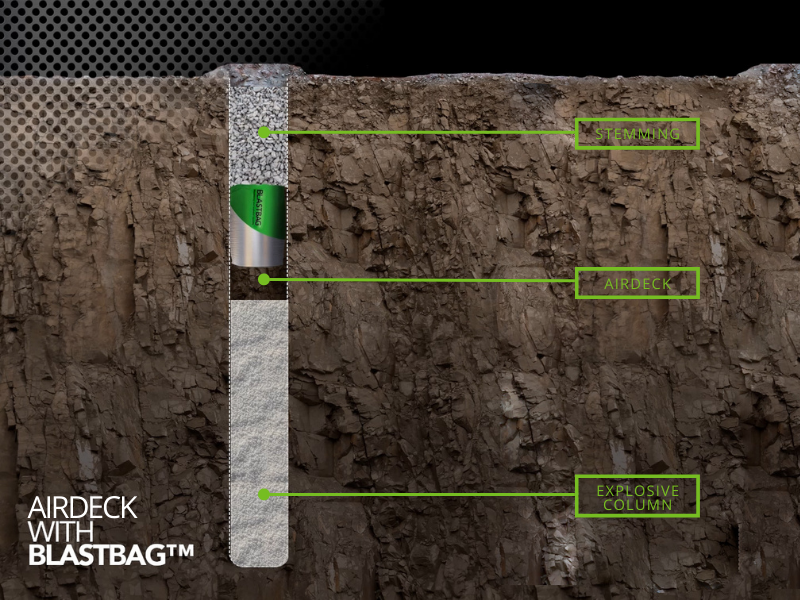
Over the decades, advances in technology, particularly our ability to track blasting data, has led to deeper insights and improved blasting techniques. Airdecking, one such technique, has garnered quite a lot of attention in the last decade. Primarily for its efficiency gains expressed in applications seeking to improve fragmentation, lower vibration and optimise explosives use.
Although widely adopted in Southern America and Australia, the concept is not universally understood and, in some cases, dismissed – often for that very reason. But as the science continues to grow and more and more operations pursue greater productivity, Airdecking as a blasting technique is gaining a substantial foothold in mainstream thinking.
The concept of an airdeck
An airdeck, as the name suggests, is a void of air created in the column of a blasthole within the loaded explosives or between the loaded explosives and stemming above it. This column of air is designed to create a space where explosive gases can expand into, allowing for a more even distribution of explosive energy over a larger area resulting in a better blast.
By introducing an air deck in a traditional explosive column, blast energy can be redistributed and optimised for the intended application.
Airdecking for better fragmentation
The size and positioning of an air deck in a blasthole effectively functions as the controls, shaping how energy is distributed. By maintaining the same amount of explosives but introducing an airdeck, the explosive energy will act over a longer length of the blasthole and surrounding rock, improving fragmentation in areas previously less subjected to the explosives’ fragmenting power.
Research also indicates airdecks can result in shock wave reflection amplifying the strain wave and further adding to improved breakage due to constructive interference of pressure waves. The airdeck can be positioned in the bottom, middle or top of the explosive column with studies indicating varying results and benefits.
When successfully applied in the appropriate geology, airdecks have typically led to a reduction in rock size of between 15-30% in the targeted area. This can have significant downstream benefits, from quicker material recovery, facilitated by better digging and haulage to more efficient crushing; Improving fragmentation can increase an operations capacity to process greater volumes of material, faster.
Highwall protection: safety and life of mine
In surface mining, the airdeck methodology has also been harnessed to minimise damage to pit walls. Trim blasts* using airdecks in the batter rows have shown less fracturing and shallower cracking beyond the pit wall post-blast. Less overall damage is important for two reasons: intact and competent walls are less likely to fail, reducing the safety risk to personnel and equipment.
Secondly, with fewer stress points in the wall, wall bearing loads are improved, paving the way for operations to excavate deeper and in effect, extend the longevity of the mine by maximising the strip ratio. In 2018, this was precisely the reason that a Chilean copper miner, like so many others, began experimenting with modified blasting techniques. It recognised the commercial risk and sought to mitigate this with a high wall protection plan compatible with its existing practices.
The results based on a self-developed system saw improvements up to 70% and 90% in key conditioning and design factors respectively.
Reducing vibration
Interestingly, while studies have shown air decks (kept within a critical length) do not diminish the work from explosives – despite the lower powder factors – they do minimise the level of vibration caused by it. The simplest application is the reduction of maximum instantaneous charge (MIC) and resulting vibration by introducing mid-column airdecks with independent initiation of both decks.
For mines and quarries close to environmentally sensitive and urban populations, this presents a solution to a perennial issue for such operators. With most jurisdictions regulated and enforcement bodies able to dictate factors such as the time of day, frequency, and occurrence of a blast, preventing regulatory intervention is key. It’s the difference between sacrificing productivity to suit regulatory guidelines or having compliant productive processes.
It’s also good practice as unmanaged vibration can damage mine infrastructure and equipment, driving up costs. In its simplest form for particular geologies, this can also be achieved with a top air deck, therefore showing a productivity gain in loading as well.
Airdecking for explosive reduction: more bang for your buck
By far the most common application for airdecking, however, is as a method of cost reduction. It has long been argued that conventional explosives use in blasting is often well in excess of what is needed to adequately fragment the rock. The problem, historically, has been due to a lack of detailed in-situ geological data and a lack of an alternative technique.
Often blasts are designed to overcompensate for unforeseen variables. In airdecks designed for this purpose, the void (positioned above the explosive column) replaces a portion of what would otherwise be loaded explosive. This technique has proven to work particularly well in soft to medium competent ground. In addition to allowing explosive gases to expand into it, this space also amplifies the shock wave; resulting in similar fragmenting power being generated despite the presence of fewer explosives. It is approximated that explosive use can be reduced by 5-15%. This is of course dependent on ground strength, the level of existing fracture, explosive type, and quality of the airdeck. A lower powder factor also means a reduction in carbon dioxide being emitted offering a high value benefit from an Environmental and Social governance perspective.
What makes a good airdeck?
To achieve the great benefits of airdecking, the tools used to create the air gap must be quality. Quality airdecks need to reliably support the load placed on top of them by the stemming, have consistent performance over time to deal with sleep times and have the ability to be positioned precisely in the blasthole. Though mechanical plugs are sometimes used, gasbags are by far better designed for the job.
With their superior ability to be accurately positioned in a hole and ability to grip it as it inflates (regardless of the conditions of the wall), gasbags can be quickly and reliably deployed, saving time, and reducing the operational burden in implementing this technique. Furthermore, quality gasbags have a high load-bearing capacity, up to 1200kg in the market-leading BLASTBAGS™ gasbags, which can maintain this load-bearing capacity for multiple days to weeks.
In conclusion, as mining continues to evolve so does our ability to respond and meet the challenges of a new day. Airdecking once considered a fringe concept is proving that conventional practices can be re-imagined. With a broad range of applications, it can be applied to airdecking and other new techniques – coupled with advances in material and better design of plugs – are raising the ceiling in what can be achieved in blasting.
*Trim blasts: using a typical reduced explosive load with increasing stemming weights


